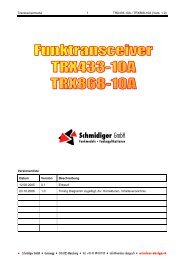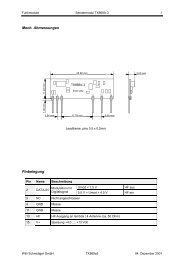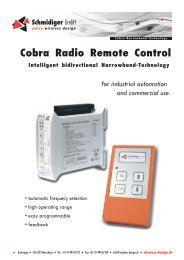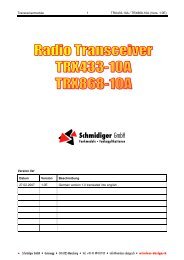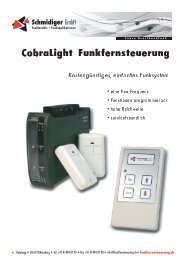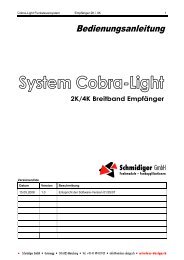Version List
Version List
Version List
Create successful ePaper yourself
Turn your PDF publications into a flip-book with our unique Google optimized e-Paper software.
Transceiver module TRX433-10C2 / TRX868-10C2 (Vers. 1.0E) 7<br />
Radio telegram structure<br />
For the radio transmission, the actual payloads are embedded in a radio telegram. The transceiver module<br />
builds the radio telegram and the associated coding and decoding and disburdens the user with that. A<br />
complete radio telegram is built according to figure 1.<br />
2ms Startup +<br />
Preamble<br />
Syncword<br />
2ms + 32 bits 24 bits 8 bits<br />
(opt.)<br />
Figure 1 structure of the radio telegram<br />
Functions of the individual blocks in the radio telegram<br />
LengthField<br />
DataField<br />
CRC16<br />
n x 8/9 bits (depends on fastsend-setting) 16 bits<br />
(opt.)<br />
2ms startup: settling time for the transmitter for the reduction of the transient emissions<br />
Preamble: allows the receiver to level out to the carrier signal of the transmitter<br />
Syncword: indiales start of the data transmission and conduces therefore to the receiver to synchronize<br />
LenthField: declares number of bytes payload in the DataField (optional)<br />
DataField: effective payload<br />
CDC16: checksum for payload in the data field (optional)<br />
Postamble: sends for the correct receiving of the last Data bits of the radio telegram<br />
Every radio telegram has to consist of 2ms Startup + Preamble, Syncword, DataField and Postamble. The<br />
blocks LengthField and CRC16 are, depending on the chosen configuration, added to the radio telegram as<br />
well. The duration of the individual blocks depends on the adjusted RF data rate and is calculated out of the<br />
number of bits multiplied by the bit duration of the adjusted RF data rate. Only the period of the 2ms Startup<br />
stays constantly 2ms with every RF data rate.<br />
Transmittion- and receiving buffer<br />
The transceiver module has a transmittion - and receiving buffer, 61 bytes each, for the serial interface.<br />
Transmittion buffer (TX-BUF)<br />
Over RS232 received data are buffered in the transmittion buffer. The space in the transmittion buffer frees<br />
byte-by-byte as soon as a byte is inserted into its place in the DataField of the radio telegramm.<br />
Receiving buffer (RX-BUF)<br />
In the receiving buffer, the over radio received data are buffered until their output over RS232. When the<br />
function “Output of the telegram-RSSI” respectively “Output of the no signal condition-RSSI” is enabled then<br />
these RSSI-values are buffered in the receiving buffer in addition to the payloads of the radio telegram.<br />
Depending on the configuration, there are maximum two additional bytes needed in the receiving buffer per<br />
radio telegram. The space in the receiving buffer for the receiving of the radio telegram has to be free by the<br />
time the radio telegram receives the actual payloads from the DataField. The space in the receiving buffer is<br />
freed byte-by-byte as soon as a byte is output over RS232.<br />
Postamble<br />
2 bits



